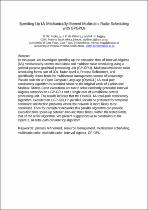JavaScript is disabled for your browser. Some features of this site may not work without it.
- ResearchSpace
- →
- Research Publications/Outputs
- →
- Conference Publications
- →
- View Item
| dc.contributor.author |
Focke, RW

|
|
| dc.contributor.author |
De Villiers, Johan P

|
|
| dc.contributor.author |
Inggs, MR

|
|
| dc.date.accessioned | 2017-01-17T09:03:58Z | |
| dc.date.available | 2017-01-17T09:03:58Z | |
| dc.date.issued | 2016-07 | |
| dc.identifier.citation | Focke, R.W., de Villiers, J.P. and Inggs, M.R. 2016. Speeding up IA mechanically-steered multistatic radar scheduling with GP-GPUs. In: 19th International Conference on Information Fusion, Heidelberg, Germany - July 5-8, 2016. | en_US |
| dc.identifier.isbn | 978-0-9964527-4-8 | |
| dc.identifier.uri | http://hdl.handle.net/10204/8918 | |
| dc.description | 19th International Conference on Information Fusion, Heidelberg, Germany - July 5-8, 2016. Due to copyright restrictions, the attached PDF file only contains the abstract of the full text item. For access to the full text item, please consult the publisher's website. | en_US |
| dc.description.abstract | In this paper, the authors investigate speeding up the execution time of Interval Algebra (IA) mechanically-steered multistatic and multisite radar scheduling using a general-purpose graphical processing unit (GP-GPU). Multistatic/multisite radar scheduling forms part of JDL fusion level 4, Process Refinement, and specifically draws from the multisensor management domain of knowledge. Pseudo code for an Open Compute Language (OpenCL) IA total-path consistency algorithm is provided based on the original work of Ladkin and Maddux. Monte-Carlo executions are run to solve randomly generated Interval Algebra networks on a GP-GPU and a single core of a multicore central processing unit. The results indicate that the OpenCL IA total-path consistency algorithm, executed on a GP-GPU in parallel, should be preferred for temporal constraint satisfaction problems where the network is more likely to be consistent. Then for consistent networks this parallel algorithm can provide execution time speed-up between two and three times, within the tested limits, that of the serial algorithm. We present suggestions as to constraints to the OpenCL IA total-path consistency algorithm. | en_US |
| dc.language.iso | en | en_US |
| dc.publisher | IEEE Xplore | en_US |
| dc.relation.ispartofseries | Workflow;17336 | |
| dc.subject | GP-GPU | en_US |
| dc.subject | Interval algebra | en_US |
| dc.subject | Multisensor scheduling | en_US |
| dc.subject | Multisite radar | en_US |
| dc.subject | Multistatic radar | en_US |
| dc.subject | Process refinement | en_US |
| dc.subject | Resource management | en_US |
| dc.title | Speeding up IA mechanically-steered multistatic radar scheduling with GP-GPUs | en_US |
| dc.type | Conference Presentation | en_US |
| dc.identifier.apacitation | Focke, R., De Villiers, J. P., & Inggs, M. (2016). Speeding up IA mechanically-steered multistatic radar scheduling with GP-GPUs. IEEE Xplore. http://hdl.handle.net/10204/8918 | en_ZA |
| dc.identifier.chicagocitation | Focke, RW, Johan P De Villiers, and MR Inggs. "Speeding up IA mechanically-steered multistatic radar scheduling with GP-GPUs." (2016): http://hdl.handle.net/10204/8918 | en_ZA |
| dc.identifier.vancouvercitation | Focke R, De Villiers JP, Inggs M, Speeding up IA mechanically-steered multistatic radar scheduling with GP-GPUs; IEEE Xplore; 2016. http://hdl.handle.net/10204/8918 . | en_ZA |
| dc.identifier.ris | TY - Conference Presentation AU - Focke, RW AU - De Villiers, Johan P AU - Inggs, MR AB - In this paper, the authors investigate speeding up the execution time of Interval Algebra (IA) mechanically-steered multistatic and multisite radar scheduling using a general-purpose graphical processing unit (GP-GPU). Multistatic/multisite radar scheduling forms part of JDL fusion level 4, Process Refinement, and specifically draws from the multisensor management domain of knowledge. Pseudo code for an Open Compute Language (OpenCL) IA total-path consistency algorithm is provided based on the original work of Ladkin and Maddux. Monte-Carlo executions are run to solve randomly generated Interval Algebra networks on a GP-GPU and a single core of a multicore central processing unit. The results indicate that the OpenCL IA total-path consistency algorithm, executed on a GP-GPU in parallel, should be preferred for temporal constraint satisfaction problems where the network is more likely to be consistent. Then for consistent networks this parallel algorithm can provide execution time speed-up between two and three times, within the tested limits, that of the serial algorithm. We present suggestions as to constraints to the OpenCL IA total-path consistency algorithm. DA - 2016-07 DB - ResearchSpace DP - CSIR KW - GP-GPU KW - Interval algebra KW - Multisensor scheduling KW - Multisite radar KW - Multistatic radar KW - Process refinement KW - Resource management LK - https://researchspace.csir.co.za PY - 2016 SM - 978-0-9964527-4-8 T1 - Speeding up IA mechanically-steered multistatic radar scheduling with GP-GPUs TI - Speeding up IA mechanically-steered multistatic radar scheduling with GP-GPUs UR - http://hdl.handle.net/10204/8918 ER - | en_ZA |






